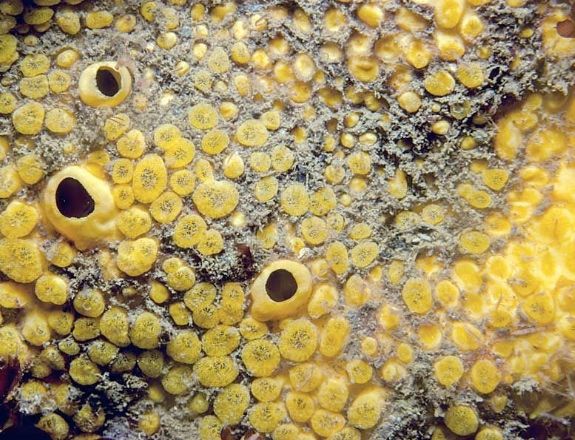Drill, Baby, Drill: Sponges Bore Into Shells Twice as Fast in Acidic Seawater
In acidic water, drilling sponges damage scallops twice as quickly, worsening the effects of ocean acidification
/https://tf-cmsv2-smithsonianmag-media.s3.amazonaws.com/filer/20130110092131boring-sponge-470.jpg)
Whenever anyone talks about ocean acidification, they discuss vanishing corals and other shelled organisms. But these aren’t the only organisms affected—the organisms that interact with these vulnerable species will also change along with them.
These changes won’t necessarily be for the good of the shell and skeleton builders. New research published in Marine Biology shows that boring sponges eroded scallop shells twice as fast under the more acidic conditions projected for the year 2100. This makes bad news for the scallops even worse: not only will they have to cope with weakened shells from acidification alone, but their shells will crumble even more quickly after their cohabiters move in.
Boring sponges aren’t named thus because they’re mundane; rather, they make their homes by boring holes into the calcium carbonate shells and skeletons of animals like scallops, oysters and corals. Using chemicals, they etch into the shell and then mechanically wash away the tiny shell chips, slowly spreading holes within the skeleton or shell and sometimes across its surface. Eventually, these holes and tunnels can kill their host, but the sponge will continue to live there until the entire shell has eroded away.
Alan Duckworth of the Australian Institute of Marine Science and Bradley Peterson of Stony Brook University in New York brought boring sponges (Cliona celata) and scallops (Argopecten irradians) into the lab to examine the effects of temperature and acidity (measured through pH) on drilling behavior. They set up a series of saltwater tanks to compare how much damage sponges did to scallops under current temperature and ocean conditions (26°C and pH 8.1), projected conditions for 2100 (31°C and pH 7.8), and each 2100 treatment alone (31°C or pH 7.8).

Under higher acidity (lower pH), boring sponges drilled into scallop shells twice as fast, boring twice as many holes and removing twice as much shell over the course of the 133-day study. The lower pH alone weakened the shells, but after the boring sponges did their work, the scallop shells were an additional 28% weaker, making them more vulnerable to predation and collapse from the sponges’ structural damage.
The sponges weren’t entirely thrilled by the water’s higher acidity, which killed 20% of the them (although the researchers aren’t sure why). Despite this loss, 80% of the sponges doing twice as much drilling meant more damage to shelled organisms in total. Temperature did not affect sponge behavior at all.
This study illustrates a classic positive feedback loop, where weakness in the shells leads to more weakness. And not through the sponge-drilled holes alone: the addition of sponge-drilled holes creates more surface area for acidification to further erode the shells, hastening each scallop’s inevitable collapse. It’s tempting to speculate out to the rest of the system—that the sponges are destroying their own habitat more quickly than scallops can produce it—but we don’t really know whether in the long run this is also bad news for the sponges.
Though a small and specific example, this study illustrates how a seemingly small change—more acid and weaker shells—can ripple out and affect other organisms and the rest of the ecosystem.
 Learn more about coral reefs from the Smithsonian’s Ocean Portal.
Learn more about coral reefs from the Smithsonian’s Ocean Portal.